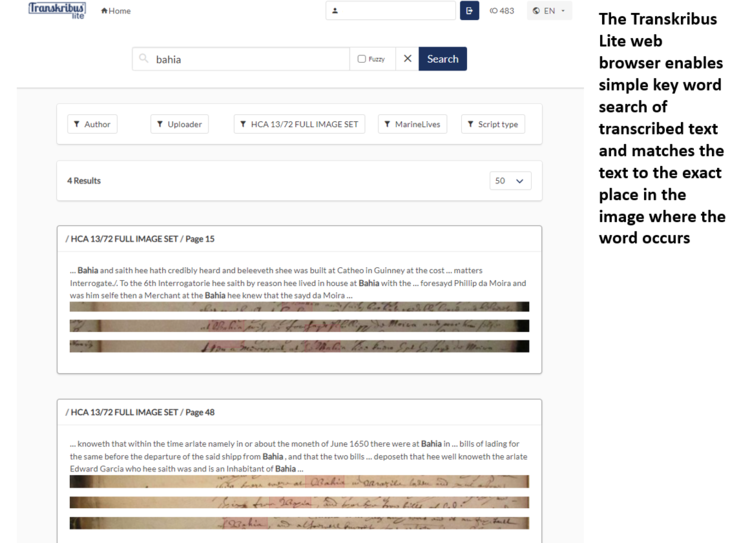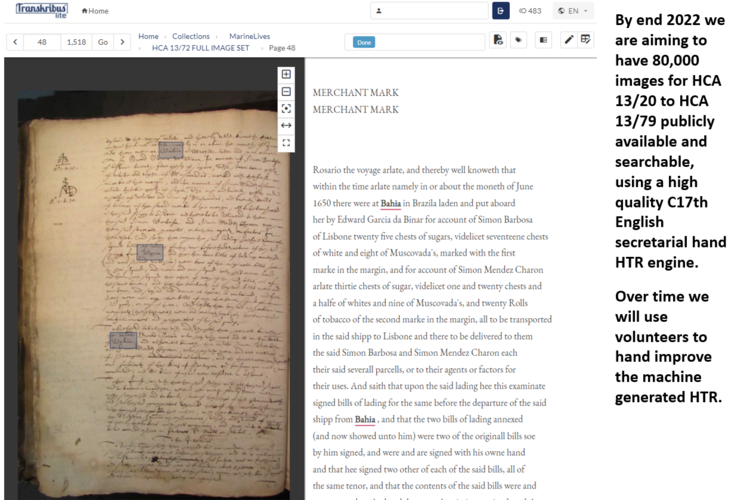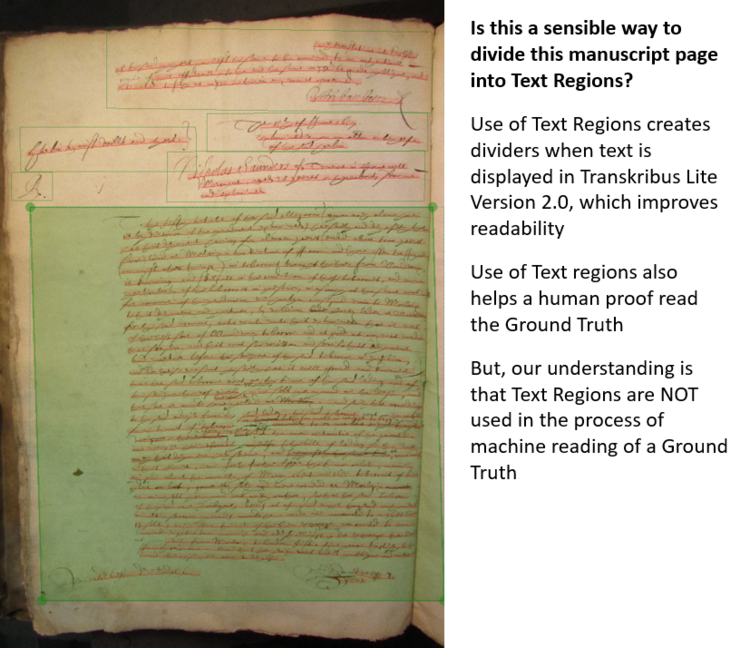Marine Lives guide to creating a Transkribus Ground Truth
This page is the main page of a guide that Marine Lives is creating to cover practical aspects of creating a Transkribus Ground Truth
Contents
Objective
Our overall objective is to make 80,000 images of English High Court of Admiralty depoitions covering 1570 to 1690 publicly available and searchable.
To do this our immediate objective is to create a C17th English secretarial hand HTR model, which we will use on our collection of 80,000 images of English High Court of Admiralty depositions.
We are aiming to create two models. The first based on a Ground Truth of 500,000 words (roughly 1,000 manuscript images). The second based on one million words (roughly 2,000 manuscript images).
For our first model, we are using existing semi-diplomatic transcriptions of the HCA 13/72 volume [late 1650s], made between 2013 and 2015 by Marine Lives volunteers. We have to convert these semi-diplomatic transcriptions back to full diplomatic, and mark up contractions, as part of the process of creating a highly reliable Ground Truth. We also have to treate interlineation differently, with each interline shown separately and the insertion point or points marked inm the line on which the interlineation depends.
Tools
Using Transkribus Expert Client
We are using Transkribus Expert Client as our main tool to perform automated layout recognition, manual correction of these layouts, and to enter and modify existing semi-diplomatic transcriptions of material in HCA 13/72.
We are then using Transkribus Lite version 2.0 to view completed Ground Truth pages, and to keep an overview of our work.
Using Transkribus Lite version 2.0
Transkribus has recently introduced an improved version of its web browser interface (Transkribus Liter Version 2.0).
Transkribus has a useful online guide to using Transkribus Lite Version 2.0.
We are finding this improved browser interface to be pretty responsive in terms of short lag times as we browse images.
The browser interface also has useful functionality not available in Transkribus Expert Client.
Most useful to date are:
Large thumbnails
Ability to display thumbnails by status of manuscript pages within our work process
Marine Lives wiki
The Marine Lives wiki is a Semantic Media Wiki. It is organised into volumes and pages.
We are working from volume HCA 13/72 and are inputing existing semi-diplomatic transcriptions from this volume by hand into Transkribus Expert Client.
Work process
We have set up a simple work process
1. Automatic layout recognition of all 1518 images in HCA 13/72
- Used the CITlab Advanced Tool
- Modified the layout page by page after manual inspection of automatically generated layouts
We are only just beginning to think through what makes sense in terms of use of Text Regions when creating our Ground Truth
We are finding that the automatic tool is typically producing between one and three Text Regions per manucript image
Typically the tool is NOT identifying text blocks on the left hand side of an image as separate from structurally separate text in the main body of text
Ideally, we would train the automatic layout recognition tool to be sensitive to the typical structures of HCA legal depositions, and we are looking into this
In the short term, we are manually adding Text Regions, and changing the shape and size of Text Regions
However, base lines of text have already been recognised and allocated to specific text regions.
We have found an easy way using Transkribus layout tools to reallocate the base lines [see below]
- The two key modifications we are making are
(a) Adjusting number size and shape of Text Regions
(b) Checking all automatically generated base lines (which themselves are "children" of a partent Text Region)
Look for breaks in base lines
Look for incomplete base lines
Connect broken base lines
Extend incomplete base lines
(c) Reallocating base lines to our newly created and/or adjusted Text Regions
2. Input of existing semi-diplomatic transcriptions of HCA 13/72 manuscript pages into Transkribus Expert Client
Once the automatically generated Text Regions have been adjusted for a specific image page
- Input the semi-diplomatic Marine Lives transcription for the relevant page, matching each line of transcribed text to the correct automatically generated line within the correct Text Region
- The chart below shows our workflow for manuscript page HCA 13/72 f.11v.
We have the Marine Lives wiki open at the correct page on the left hand side of our screen.
In the middle and on the right hand of our screen we have the Transkribus Expert Client open with the Layout Tab open in Transcription View.
This enables us to see the relevant part of the image, with the relevant Text Region.
We are pasting transcribed text against the correct lines.
To ensure a good human overview, we have pasted two or three lines of transcribed text into each Text Region
This gives us good human oversight of the document.
Then we work methodically through all the text
QUESTIONS
We are developing a running list of questions.
Some of these questions we will probably be able to answer ourselves, as we get more experience of building our Ground Truth.
But, in the meantime, we would appreciate sugegstions from fellow Transkribus users.
Question One
Is this a sensible division of this page into Text Regions?
Question Two
Is it best practice to avoid overlapping Text Regions by using irregular shapes? Or, is it better to keep rectangular shapes, aligned horizontally with image, and to accept overlapping Text Regions?
Question Three
How can we train the Transkribus automatic layout tools to understand the range of document structures we have?
Typical structure and variations
HCA depositions are typically structured with three implied columns of text. Depositions can be as short as a quarter of an image page, or as long as ten image pages.
Most HCA deposition image pages have an implied three column structure.
At the start of a deposition, there may be a date, which is usually in the central column. There is then the long or short form name of the cause, which is usually in the left hand column. At the same horizontal level, or somewhat lower follows the full name of the individual being examined (the deponent), together with their residential location, their occupation and age. These data, which we for convenience call the "Personal Front matter" typically runs across the central and right hand column.
The main body of the deposition (answers to an allegation or libel, or to interrogatories) is in the centre and right of a page.
At the same horizontal level as the main body of the deposition, there may be additional data in the left hand column. For example, merchant markes (typically these are pictograms), referred to in the main body.
At the foot of the main body of a deposition, there is a signature, mark or initial(s) (which we describe together as "Signoffs") of the person being examined. This may be can be in the central column, the right hand column, or running over both the central and right hand columns.
Near the horizonal level of the signoff, there is usually some legal boilerplate in the left hand column.
Human reading of our documents
Human beings read legal depositions by starting in the top left hand side of a page, then moving their eyes to the first block of text on the left and then the right, in a zig zag
Machine reading of layout
Can we manually teach programme an automatic layout recogniser to look for certain types of Text Region (by size and shape and amount of text) and to number the Text Regions detected in a bespoke order
For example:
Always look to the top right hand corner of a page, if the page is a recto page
If no page number in top right hand corner, look for pencil page number elsewhere at the top of the page
Look for single leads detached from other text blocks and create Text Region
Always create a Text Region if a certain minimum of non-text surrounds the text
Recognise curly brackets and always place text which has curly brackets on the right of it within a discrete Text Region
Work in a Zig Zag from top RH corner of a page with the Text Rehions numbered according to their presence (or not) on that Zig Zag pattern?
Can we as an alternative start by hand defining all teh Text Regions we want on a given page and THEN running the automatic layout recognition, with the recognition program identifying only base lines, and assigning them to our manually chosen Text Regions?
Question Four
How should we chose the best range of documents to include in our Ground Truth?
Should we chose a wide range of handwriting types under the umbrella of "Notarial Secretary Hand?
Should we chose only well lit, high quality images, or is there an argument to include images in diverse lighting conditions and different degrees of focal accuracy?
How sensitive is the machine learning process (and the subsequent accuracy of an HTR model) to very accurately defined base lines, versus very accurately transcribed text?
How does the machine learning process treat text in the Ground Truth which is either blacked out (no text visible) or struck out (but where the text is still visible)?
Is it important to have plenty of examples of interlineation and marginalia to train an HTR model to be flexible, or do these actually reduce the accuracy of an HTR model?
Question Five
How should signatures be treated?
Should signatures be in their own Text Region, or should they be included in the Text Region which contains the main text with which they are associated?
Question Six
How should pictograms containing some text be treated?
English High Court of Admiralty depositions often contain Merchants Marks, which are essentially pictograms. These pictograms sometimes include letters, numbers or words. How should these be treated im terms of Text Regiona nd base lines?








